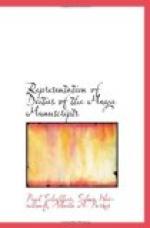Since, for the most part, the accounts of Spanish authors regarding the mythology of the Mayas correspond only slightly or not at all with these figures of gods, and all other conjectures respecting their significance are very dubious, the alphabetic designation of the deities, which was tentatively introduced in the first edition of this work, has been preserved. This designation has proved to be practical. For the plate at the end of this pamphlet, examples as characteristic as possible of the individual figures of gods have been selected from the manuscripts.
It is a well known fact that we possess no definite knowledge either of the time of the composition or of the local origin of the Maya manuscripts. The objection might, therefore, be raised that it is a hazardous proceeding to treat the material derived from these three manuscripts in common, as if it were homogeneous. But these researches themselves have proved beyond a doubt, that the mythologic import of the manuscripts belongs to one and the same sphere of thought. Essentially the same deities and the same mythologic ideas are, without question, to be found in all the manuscripts.
The material of the inscriptions has been set entirely at one side, because the style of representation contained in them, both of the mythologic forms and of the hieroglyphs, renders comparison exceedingly difficult. In this field especial credit is due to Foerstemann and Seler, for the work they have done in furtherance of interpretation, and mention should not be omitted of the generosity with which the well known promoter of Americanist investigations, the Duke of Loubat, has presented to the Berlin Museum of Ethnology costly originals of reliefs and inscriptions for direct study. The representations on the reliefs from the Maya region, it is true, give evidence of dealing with kindred mythologic conceptions. Figures and hieroglyphs of gods, made familiar by the manuscripts, can also be found here and there. But on the whole so little appears in support of instituting a comparison with the manuscripts, that it seems expedient to leave the inscriptions for independent and special study.
I. REPRESENTATIONS OF GODS.
A. The Death-God.
[Illustration: Figs. 1-6]
God A is represented as a figure with an exposed, bony spine, truncated nose and grinning teeth.[10-1] It is plainly to be seen that the head of this god represents a skull and that the spine is that of a skeleton. The pictures of the death-god are so characteristic in the Maya manuscripts that the deity is always easily recognized. He is almost always distinguished by the skeleton face and the bony spine. Several times in the Dresden manuscript the death-god is pictured with large black spots on his body and in Dr. 19b a woman with closed eyes, whose body also displays the black spots, is sitting opposite the god. While the Aztecs had a male and a female death-deity,




